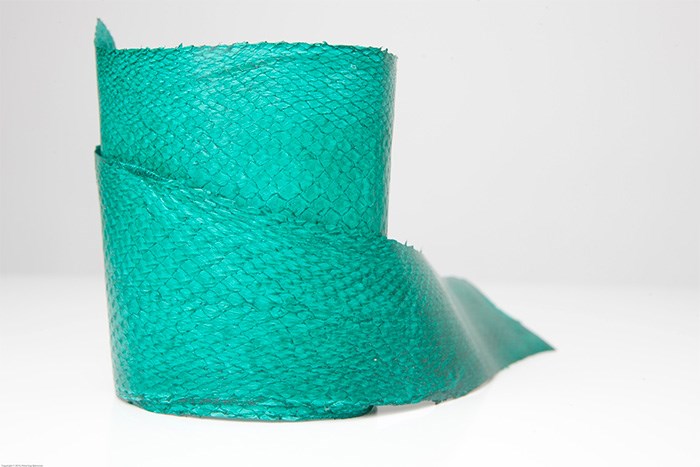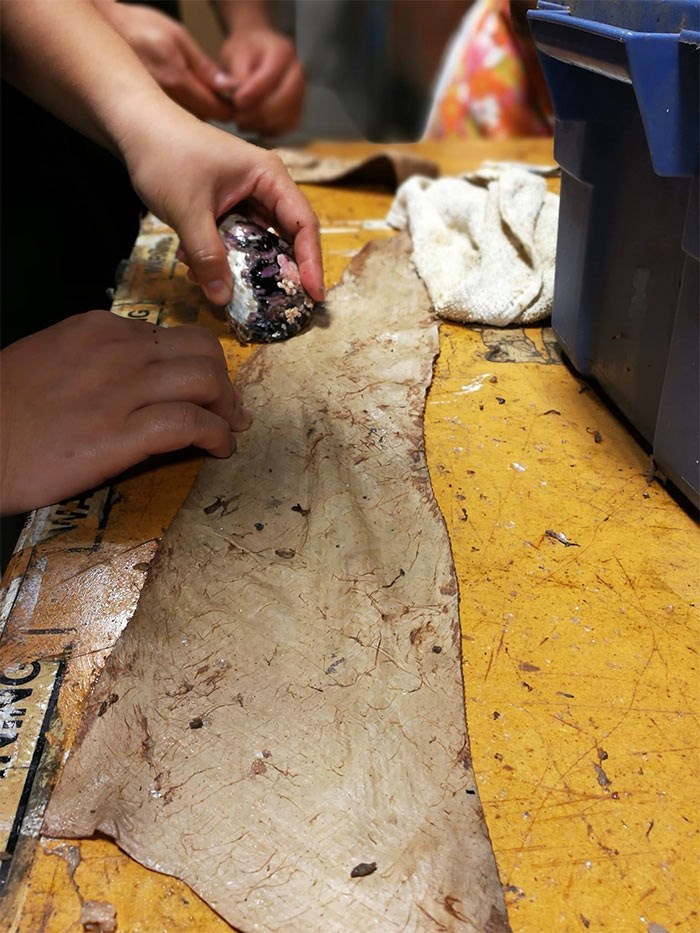 Would you wear leather made from fish skin? — Atlantic Leather photo
Would you wear leather made from fish skin? — Atlantic Leather photo
On a recent Thursday evening, a group gathered on the docks by Granville Island to learn about making leather from fish skins.
Skins that would be discarded as waste were scraped and tanned. They could then be fashioned into anything from handbags to high-end sneakers, acting as a modern alternative to exotic leathers.
Rebecca Graham, a local artist, weaver and maker who led the workshop, discovered the world of fish leather while learning about traditional leather and tanning: “I got interested in all leather. It’s a cornerstone of ancestral skills from all over the world, and yet we’re so removed from the process now that we can’t really honour or appreciate it.”
The community learning circle was part of the Land and Sea project, an initiative of the environmental group EartHand Gleaners, in which artists, fishermen and community members from Indigenous and non-Indigenous communities “weave together coastal materials and processes,” from fish leather and nettle to linen and net-making.
 Prepping the skin for tanning. – Rebecca Graham photo
Prepping the skin for tanning. – Rebecca Graham photo
Fish leather may be new to some, but it has a long history in B.C. First Nations cultures. Graham notes that her friend Tracy Williams, who is Skwxwu7mesh, says that her elders tell her fish leather was used for shoes. Another friend, Rosemary Georgeson, who is Coast Salish and Sahtu Dene, explains that her father, a fisherman, said their ancestors used to make things out of fish leather and she assumed he was telling “tall tales.”
Up the coast, there are makers in Alaska who are creating beautiful objects out of fish skin, and, next year, Graham hopes to invite June Pardue, a salmon sewer from Alaska, to share her skills.
Graham says she has a photo from a museum in Japan that shows an ancient pair of boots made out of salmon, with the dorsal fins on the bottom; “the panel beside them says the dorsal fins were left on to act like rudders on the ice.”
Fish-leather tanneries in Australia (Mermaid Leather) and Iceland (Atlantic Leather) are currently making fish leather for an expanding high-end market. Nike, Alexander Wang, Prada, Ferragamo and Dior have all used fish leather in their designs. A group in Alaska is also hoping to start a fish-leather tannery.
Partnering with Skipper Otto’s, a community-supported fishery, has been fascinating, notes Graham. “Going down to the docks and chatting with the fishermen, getting a glimpse into a different world – their livelihoods are based on the land and sea and that means a huge shift in awareness and knowledge. It’s such a contrast with the cityscape around us, I get more information than I can take in.”
The biggest challenge, Graham says, has been finding their footing in the supply chain and getting the skins needed to make the leather.
“Lots of Skipper Otto’s fish are so beautiful, they go to the consumer as is. I saw some troll-caught chinooks that were iridescent blue and silver – gorgeous.” Nevertheless, she just got two boxes of chum skins from Skipper Otto’s that were cold-smoked for lox. As Graham points out, smoking is a form of tanning, so she’s doing some testing to see if she can complete the process with vegetable tannins. If it works, it will be amazing leather, she says. “The chum are huge with thick, strong skins.”
Graham adds that the most important part of the recent workshop was when they spoke about honouring the salmon. She says she saw Ronnie Deane Harris (a.k.a. Ostwelve) speak at the Bill Reid Gallery for the opening of the Intangible exhibition a few weeks ago, and he talked about his passion for the Wild Salmon Caravan, and that for the first time, his people in Yale have no dried salmon this year. “I hope that our work with the salmon leather can benefit the salmon in some way.”
The Salmon Leather Guild, a four-session workshop beginning Oct.12, will be a more in-depth exploration of fish leather, involving the process of selecting, scraping, tanning and finishing fish leather, then stitching it into a leather wallet.
Read more from the Westender


